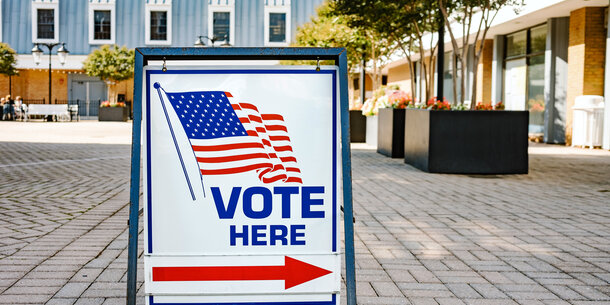Georgia’s most recent efforts to suppress voting led Major League Baseball (MLB) to pull its All-Star Game out of the Peach State. Some criticized the move, arguing that it is easier to vote in Georgia than in Colorado, the new site of the All-Star Game, or in New York, the home of MLB headquarters. The comparison to New York is misguided. The comparison to Colorado is downright absurd.
Colorado and Georgia Are Not in the Same Ballpark
Some pundits have suggested that Colorado is as bad or worse than Georgia when it comes to voting policy. That claim is absurd. Colorado is widely seen as a leader among states in expanding access to democracy. In 2020, the state had the second-highest turnout rate in the country. Despite record political spending and turnout, Georgia only made it to the middle of the pack — 26th among the states. Georgia should aspire to be where Colorado is. Instead, it seems intent on heading to where New York once was.
- There is no real comparison between the voter ID requirements in Georgia and Colorado.
- Colorado’s in-person voter ID requirement allows voters to present a wide range of IDs, including utility and bank statements. Georgia’s law limits voters to a narrow list of photo IDs.
- Colorado has a universal vote-by-mail system that automatically mails a ballot to every registered voter in advance of the election. As a result, only 6 percent of Colorado voters cast a ballot in person, making the in-person voter ID requirement largely irrelevant.
- Not only do far more voters vote in person in Georgia, but SB 202 imposes onerous new ID requirements on mail voters as well.
- It is disingenuous to compare the number of early voting days in Colorado, where almost all voters vote
by mail, and Georgia, where only a small segment of voters do.
- Colorado provides more than enough early voting for its relatively few in-person voters. While Georgia is infamous for long lines at the polls, Colorado’s secretary of state estimates that many early voting centers in her state see less than one person per hour voting on average.
- Colorado offers wider voting access in many other ways as well.
- In Georgia, SB 202 caps drop boxes in large counties at one per 100,000 active voters. By contrast, Colorado offers more than one drop box for every 10,000 voters. Colorado also makes drop boxes available around the clock, while they are only available during regular voting hours in Georgia.
- Colorado also offers same-day registration, pre-registration for 16-year-olds, and an innovative “TXT2Cure” program that allows voters to fix problems with their ballots via text message, options not available to Georgia voters.
As New York Rallies, Georgia Throws the Game
Neither Georgia nor New York provides a model for inclusive democracy. And there are certainly a number of ways in which Georgia is ahead of New York on voting access. For a long time, New York was among the worst states in the country on many voting measures. But Georgia’s defenders certainly aren’t scoring any points by boasting that they beat New York on implementing reforms like early voting — nearly every state did.
The critical difference is that Georgia and New York are headed in opposite directions. Since 2019, New York’s legislature has swiftly moved to expand democracy by passing laws that provide for early voting, online voter registration (OVR), and automatic voter registration (AVR). It has also begun the constitutional amendment process to provide for Election Day registration and no-excuse mail voting. Georgia, on the other hand, is responding to record turnout by making it harder to vote, rolling back the very policies that put it ahead of New York in the first place.
- Georgia made it a crime to give water or snacks to voters waiting in long lines. Contrary to some claims, New York has no such ban. New York does put a one-dollar limit on the food and drink that can be provided to a voter, but when purchased in bulk, bottled water and snacks easily fall below this limit.
- Georgia is restricting access to mail voting while New York is expanding it.
- For years, Georgia let everyone vote by mail. But after 2020, in which Black and Democratic voters
relied disproportionately on mail voting amid the pandemic, its legislature passed SB 202, creating
significant barriers to that method of casting a ballot:
- The bill requires voters to include a driver’s license or state ID number on their mail ballot application. If they don’t have one, they must attach a photocopy of another form of ID to their application.
- The bill requires voters to go through this process all over again when they return their mail ballot.
- The bill severely limits the availability of drop boxes for returning mail ballots, limiting counties to the lesser of one drop box per 100,000 active registered voters or one drop box per early voting site.
- New York is behind Georgia on absentee voting — 2020 was the first year in which New Yorkers didn’t need an “excuse” to vote by mail, and that was only because the legislature deemed the coronavirus pandemic an acceptable excuse. The limitation on mail voting is written into New York’s constitution, which takes years to change. Fortunately, the state is well on its way to passing a constitutional amendment to eliminate the excuse requirement for absentee voting. The legislature passed the proposed amendment once and is poised to pass it a second time, which will send it to the voters for approval in November 2021.
- Although New York still has work to do to make mail voting available to everyone on a permanent basis,
it is already doing better than Georgia on the specifics in SB 202:
- New York does not impose an ID requirement for voters to apply for an absentee ballot or to cast one.
- New York has no population limitation on drop boxes. Although it currently only provides drop boxes at board of elections offices and polling places, the state senate has passed a bill that would remove that limitation as well.
- For years, Georgia let everyone vote by mail. But after 2020, in which Black and Democratic voters
relied disproportionately on mail voting amid the pandemic, its legislature passed SB 202, creating
significant barriers to that method of casting a ballot:
- Georgia may offer more days of early voting than New York, but New York allocates more weekend and
evening hours.
- Georgia’s SB 202 takes some discretion away from counties as to the hours in which they can make early voting available. Though it raises the floor for weekend voting days and requires at least 17 days of early voting, it also limits how much counties can expand early voting: no county can offer voting before 7 a.m. or after 7 p.m. on any day.
- New York finally introduced early voting in 2019 and offers only nine days of early voting. Still, New York requires more days of weekend voting than Georgia, including two Sundays. New York also mandates that polls stay open until 8 p.m. on at least two weekdays during early voting and that they remain open from 6 a.m. to 9 p.m. on Election Day.
- Georgia disenfranchises many voters in the community with past criminal convictions. New York does not.
- As a result of an executive order from the governor, New York restores voting rights to everyone upon release from prison — and the legislature is on the verge of codifying that policy. Georgia, on the other hand, disenfranchises more than 200,000 people who have served out their sentences and are now living in the community.
New York Still Has a Way to Go If It Wants to Take the Pennant
New York still has plenty of work to do to improve its elections. The dramatic progress state lawmakers have made on voting policy in the last few years was necessary just to bring New York’s elections into the 21st century.
- The state still needs to complete the constitutional amendment process to provide for no-excuse absentee voting and same-day registration. Both of these reforms will require implementing legislation as well.
- Though it appears poised to do so, the legislature has yet to codify the automatic restoration of voting rights to people upon release from prison. The state’s felony disenfranchisement policy is a remnant of Jim Crow in the North.
- A number of the new policies the state has passed, including AVR and an OVR system that is accessible to those without DMV records, have yet to take effect. Implementation of OVR has been delayed well beyond the statutory deadline because of the state’s failure to provide adequate funding to its board of elections.
- Although New York finally began providing early voting in 2019, it struggled with implementation, with long lines forming at New York City polling places in 2020.
- New York’s struggles aren’t just a matter of retrograde policy. The state also suffers from failures of election administration. In order to build a truly inclusive democracy, New York will need to overcome a long history of patronage and poor funding, among other issues.



